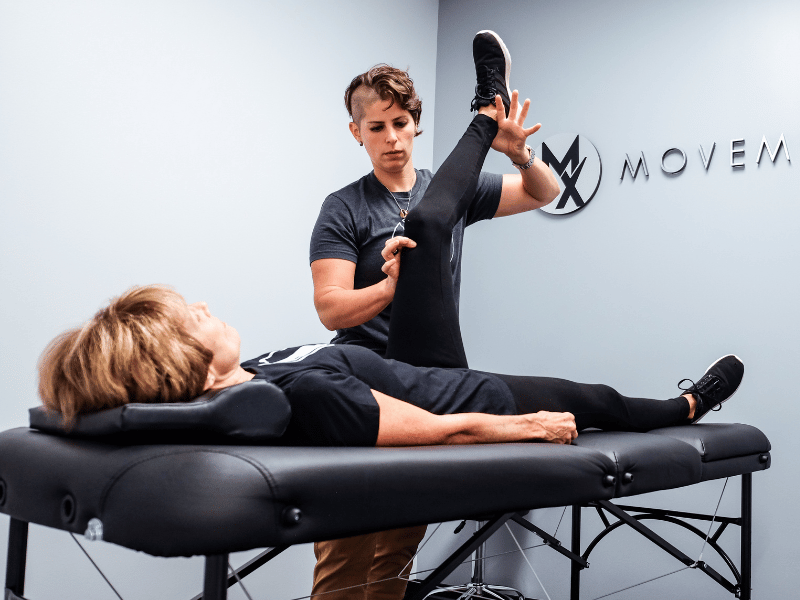Piriformis Syndrome: Is This the Cause of Your Sciatica or Pelvic Pain?
Two conditions that are common among the population include sciatica—which has a lifetime prevalence of 15-40%—and chronic pelvic pain—which affects 6-36% of the population. While these pain problems may seem disparate, there is one syndrome that can lead to symptoms that mimic both problems: piriformis syndrome.
Piriformis syndrome occurs when a muscle of the posterior hip (the piriformis) impinges or irritates the sciatic nerve (the nerve that goes down the back of the leg). This irritation can lead to pain in the buttocks, radicular symptoms in the back of the thigh, or both. Up to 5% of all cases of low back, buttock, and leg pain are attributed to piriformis syndrome (1-5).
Additionally, because of the close anatomical relationship the piriformis muscle has to other muscles of the pelvic floor, tension in the piriformis can lead to pain in the pelvic region including in the urethra, vagina and rectum. This can cause normal activities like intercourse, urination, defecation, and sitting to become unbearable (1-2).
So how do you know if the piriformis muscle is the cause of the pain in your butt? By continuing to read, you’ll gain valuable insights into the symptoms, causes and treatment options for piriformis syndrome, including how physical therapy can play an important role in your recovery. We’ll share expert tips, exercises, and preventable measures to help you move from pain to comfort. Whether you’re newly experiencing symptoms or have been managing piriformis syndrome, sciatica, or pelvic pain for a while, this guide is designed to provide you with the knowledge and tools to improve your pelvic health and overall well-being.
What is Piriformis Syndrome?
Piriformis syndrome occurs when the piriformis muscle becomes chronically contracted and pushes on the sciatic nerve. The piriformis muscle is a deep hip muscle that spans from the sacrum to the greater trochanter of the femur. It passes directly over the sciatic nerve and is the only muscle that has this close of a relationship to the sciatic nerve. The piriformis is an important muscle for hip stability, pelvic floor support, and leg movement.
Pain consistent with piriformis syndrome can occur when we stand or sit in certain postures for prolonged periods of time, experience trauma, or need to compensate for weakness in the pelvic floor, core or glute muscles. These mechanisms can lead to the piriformis becoming overused and therefore increase tightness and spasm within the muscle. When the muscle cannot move through its normal range of motion, it presses on the sciatic nerve, leading to irritation, pain and sometimes even numbness and tingling—symptoms that mimic sciatica (a sciatic nerve irritation that originates from the low back).
Symptoms of Piriformis Syndrome
Symptoms of piriformis syndrome can vary in intensity leading to mild discomfort to debilitating pain. Early recognition can lead to timely and effective management, potentially alleviating discomfort and preventing further chronic complications, including pelvic floor dysfunction.
The symptoms (1-5) of piriformis syndrome may include:
- Pain in the buttock: This is often the most common symptom, typically felt deep in the buttock area.
- Radiating pain: The pain may radiate down the back of the thigh, calf, and foot, mimicking sciatica.
- Pain in the vagina or rectum: The piriformis muscle is closely related to the pelvic floor muscles and can refer pain to the perineum of the pelvis. This can also manifest as dyspareunia (pain during intercourse), pain during defecation or coccydynia (tailbone pain).
- Numbness and tingling: Some people may experience numbness or tingling sensations in the buttock or along the path of the sciatic nerve.
- Difficulty sitting: Sitting for long periods can exacerbate the pain, especially on hard surfaces.
- Pain with movement: Activities that involve hip rotation, such as walking, climbing stairs, or running, may increase discomfort.
It’s important to understand the mechanism behind piriformis syndrome because sometimes it can be indicative of other conditions. If the pelvic floor is especially affected, a pelvic health physical therapist may be the best choice for conservative symptom management.
Causes of Piriformis Syndrome
The causes of piriformis syndrome are complex and multifaceted, and involve a combination of factors. Understanding common risk factors and how they are frequently associated with the condition can provide insights into its potential origins.
Here are some of the common causes or risk factors associated with piriformis syndrome:
- Muscle overuse: Repetitive activities that involve the lower body, such as running or cycling, can lead to overuse of the piriformis muscle.
- Muscle imbalances: Weak or tight muscles in the hip, lower back, or pelvis (including the pelvic floor) can contribute to abnormal piriformis muscle function.
- Trauma or injury: Direct trauma to the buttock or hip area, such as a fall or accident, can lead to piriformis syndrome.
- Anatomical variations: In some individuals, the sciatic nerve may pass through the piriformis muscle, increasing the risk of nerve compression.
- Prolonged sitting: Sitting for extended periods, particularly with poor posture, can strain the piriformis muscle and contribute to the syndrome.
- Postural habits: Certain postural habits alter the biomechanics of the lower extremity and increase workload on the piriformis leading to an increased risk for piriformis syndrome.
- Pregnancy: As a pregnancy progresses, there is more pressure on the pelvic floor and less space in the pelvic cavity. This can lead to increased compression of the sciatic nerve and increased biomechanical stress on the piriformis.
- Childbirth: The pelvic floor muscles have to stretch 300% their normal length in order to deliver a baby through the vaginal canal. Pelvic floor muscle tearing and trauma can result on increased workload to the piriformis and result in symptoms during the postpartum period.
- Stress: The pelvic floor is a common place for stress to manifest which can lead to increased strain on the piriformis.
Having one or more of these risk factors does not guarantee the development of piriformis syndrome. However, they can increase the likelihood of experiencing symptoms. Recognizing these factors can be a crucial step in managing or preventing hip or pelvic pain, as it allows individuals to address potential contributing elements in their health and lifestyle.
Treatment Options for Piriformis Syndrome
Managing piriformis syndrome requires a comprehensive approach tailored to the individual’s specific symptoms and underlying causes. Fortunately, several treatment options are available, ranging from conservative self-care practices and physical therapy to more invasive procedures for severe cases. It’s essential to consult with healthcare professionals to determine the most appropriate treatment plan for your situation.
Treatment for piriformis syndrome aims to reduce pain, alleviate muscle tension, and improve function. Common treatment options include:
- Rest and activity modification: Reducing activities that aggravate symptoms and incorporating rest can help the muscle heal.
- Cold and heat therapy: Applying ice to reduce inflammation or heat to relax the muscle can provide relief.
- Medications: Nonsteroidal anti-inflammatory drugs (NSAIDs) can help reduce pain and inflammation.
- Injections: Corticosteroid or anesthetic injections may be used to reduce pain and inflammation in severe cases.
- Physical therapy: Targeted exercises and stretches to relieve pressure on the sciatic nerve and strengthen supporting muscles are crucial. Pelvic floor physical therapists can address the influence of the pelvic floor muscles on reoccurrence and prevention of the condition. Physical therapists may also use techniques such as manual therapy and dry needling to improve mobility, muscle function and relieve pain.
- Alternative Therapies: Some individuals find relief through alternative therapies, including acupuncture, chiropractic treatment, or massage, which may help reduce muscle tension and pain.
Physical therapy stands out among these options due to its non-invasive nature and the tailored approach it offers for symptom relief and functional improvement. Through a combination of targeted exercises, manual therapy, and patient education, physical therapists address the root causes of piriformis syndrome, promoting long-term health and preventing recurrence. In the next section, we’ll delve deeper into the role of physical therapy in treating piriformis syndrome, highlighting its benefits and what you can expect during your treatment journey.
How Physical Therapy can help with Piriformis Syndrome
Physical therapy is a cornerstone in the treatment of piriformis syndrome, offering a personalized, non-invasive, and holistic approach to recovery. By collaborating with a skilled physical therapist, particularly one specializing in orthopedics or pelvic health, individuals with piriformis syndrome can receive care tailored to their specific condition, lifestyle, and goals. This customized approach ensures that therapy not only addresses immediate symptoms but also supports long-term health and function (6-7).
In your initial visit, your physical therapist will conduct a comprehensive movement assessment to uncover the root causes of your pain. This evaluation may include an examination of your range of motion, strength, flexibility, posture, and overall mobility. Your physical therapist will then explain their findings, offering insights into how certain movements, postures, or habits—such as standing with locked knees or sitting with your knees together—might contribute to your condition. They will also suggest strategies for modifying these behaviors and provide guidance on how to adjust daily activities to prevent further irritation of the piriformis muscle, ensuring that progress continues between sessions.
Effective physical therapy for piriformis syndrome hinges on three critical needs for nerve health: movement, space, and blood flow. In piriformis syndrome, the sciatic nerve often becomes irritated due to compression by the piriformis muscle, restricting its space and movement. The first phase of treatment focuses on creating space for the nerve by reducing tension and spasms in the piriformis and surrounding muscles, such as the glutes, pelvic floor, and lower back. Techniques like joint mobilization, soft tissue mobilization, myofascial release, and trigger point releases are commonly used to alleviate these muscle spasms and improve mobility. For those with significant pelvic involvement, a pelvic health physical therapist may perform internal trigger point releases or prescribe tools like a pelvic wand for self-care at home. Trigger point dry needling is another effective technique that can quickly relieve muscle spasms and restore range of motion, often providing rapid pain relief.
As space is restored for the sciatic nerve, the focus shifts to enhancing the mobility of the nerve and surrounding structures. Your physical therapist will design a personalized exercise program to improve your overall mobility, strengthen and stretch the muscles of the hip, pelvic floor, back, and core, and enhance sciatic nerve mobility. These exercises aim to correct alignment, alleviate discomfort, and restore function. Pelvic health physical therapists can also address how the pelvic floor muscles influence piriformis syndrome, helping to prevent recurrence and ensuring comprehensive care.
Physical therapy for piriformis syndrome embodies a holistic approach that not only addresses the symptoms but also empowers you with the knowledge and skills to manage your condition effectively. By fostering an understanding of your body’s mechanics and providing hands-on treatment, physical therapy can significantly improve your quality of life, offering a path towards lasting relief and recovery from piriformis syndrome.
Our Top Exercises & Stretches for Piriformis Syndrome
Here are three exercises and stretches recommended to aid in the treatment of piriformis syndrome. Remember, these are general suggestions, and it’s crucial to consult with a MovementX physical therapist to tailor these exercises to your specific needs and ensure they are performed correctly.
Self Piriformis Soft Tissue Mobilization with a Small Ball
-
- Setup: Begin sitting upright on the floor. Place a small, firm ball below your buttock muscle and cross your same side leg over the other.
- Movement: Slowly roll your buttock muscle up and down on the ball until you feel a stretch or muscle release. Hold briefly on any tight spots, then continue rolling.
- Tip: Make sure to use just enough pressure that you feel a stretch or discomfort, but no pain.
Figure 4 Piriformis Stretch in Supine
-
- Setup: Begin lying on your back with both legs bent and your feet on the ground.
- Movement: Lift one leg and place that ankle on your opposite knee, then apply a gentle pressure to your bent knee with your hand. You should feel a stretch in your buttocks. Hold for 10 seconds. Release and repeat.
- Tip: Make sure to keep your low back flat on the floor during the stretch.
Figure 4 Piriformis Stretch in Sitting
-
- Setup: Begin sitting upright in a chair with both feet on the ground. Bring the ankle of one leg up onto the knee of your opposite leg.
- Movement: Apply a gentle pressure with one hand on the top of your bent knee, and lean forward until you feel a stretch in your buttocks. Hold for 10 seconds. Relax, then repeat.
- Tip: Make sure to keep your shoulders relaxed and back straight during the exercise.
It’s essential to approach these general exercises with caution and listen to your body. If you experience any pain or discomfort, stop the exercise and consult with a professional.
Disclaimer: Before starting any exercise program for piriformis syndrome, it’s advised to consult with a MovementX physical therapist. A personalized assessment can ensure that the exercises and stretches are appropriate for your specific condition and are performed correctly to maximize benefits and minimize the risk of injury.
Prevention of Piriformis Syndrome
Preventing piriformis syndrome involves maintaining muscle balance, flexibility, and strength. Tips for prevention include:
- Regular stretching: Incorporate stretching exercises for the hips, glutes, hamstrings, and lower back into your daily routine.
- Strength training: Focus on strengthening the core, hips, and lower body to support proper alignment and movement.
- Avoid prolonged sitting: Take breaks to stand, walk, or stretch if you sit for long periods.
- Avoid locking your knees: Locking your knees when you stand changes the position of the pelvis and leads to increased workload on the muscles of the lower back and pelvic floor, including the piriformis. Keeping your knees slightly relaxed when you stand, improves the biomechanical load to the glutes and core, allowing a more equal distribution of workload.
- Warm-up before exercise: Always warm up before engaging in physical activity to prepare your muscles for movement.
- Listen to your body: If you experience pain or discomfort, reduce the intensity of your activities and seek professional guidance.
Conclusion
Piriformis syndrome can be a painful and debilitating condition, but with the right treatment and preventive measures, it can be effectively managed. Understanding the symptoms, causes, and treatment options is essential for those affected by the condition. Physical therapy plays a crucial role in recovery, offering targeted exercises and techniques to alleviate symptoms and prevent recurrence. By incorporating the recommended exercises and adopting preventive strategies, individuals can reduce their risk of developing piriformis syndrome and maintain a healthy, active lifestyle.
If you’re finding that pain is impacting your daily activities, or if you’re pregnant and struggling with sciatica, know that relief is possible. You don’t have to face this challenge alone. At MovementX, we’re dedicated to guiding you through a personalized physical therapy experience tailored to your unique needs and goals. Our expert physical therapists specialize in treating piriformis syndrome and are committed to helping you achieve lasting relief.
Take the first step toward a pain-free life. Request a session with MovementX today, and let us support you on your journey to recovery and wellness.
References
- Yuan X, Bevelaqua AC. Buttock pain in the athlete: the role of pelvic floor dysfunction. Curr Phys Med Rehab Report. 2018; 6:147-155.
- Barzak B, Hankus K, Mielczarek A, Woznial S. The piriformis muscle syndrome—anatomy, diagnosis and the role of physiotherapy. A review. Med J Cell Bio. 2023: 40-43.
- Hopayian K, Song F, Riera R, Sambandan S. The clinical features of the piriformis syndrome: a systematic review. Eur Spine J. 2010; 19:2095-2109.
- Jankovic D, Peng P, van Zundert A. Brief review: piriformis syndrome: etiology, diagnosis and management. J Can Anesth. 2013; 60: 1003-1012.
- Hopayian K, Danielyan A. Four symptoms define the piriformis syndrome: an updated systematic review of its clinical features. Eur J Orthop Surg Traumatol. 2018; 28: 155-164.
- Ahmad Siraj S, Dadgal R. Physiotherapy for Piriformis Syndrome Using Sciatic Nerve Mobilization and Piriformis Release. Cureus. 2022; 14(12): e32952.
- Guner D, Ozcete Z A (August 20, 2023) Evaluation of the Efficacy of Ultrasound-Guided Dry Needling Therapy and Exercise in Piriformis Muscle Syndrome. Cureus 15(8): e43804.
Share This Page
More Conditions We Treat
Found this page interesting? Learn more about other conditions we treat:





